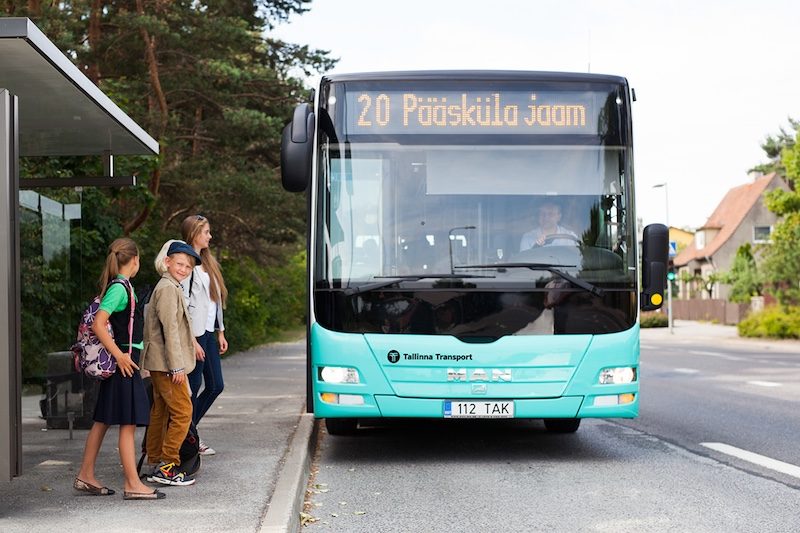Let us take care of ourselves!

The campaign “Take care of yourself! Hold on!” launched by the police a few years ago has proved fruitful. Most public transport users have realized that it is safer to travel on a moving bus or tram when sitting; and when standing in the absence of a free place, the handrail must be held onto. Nevertheless, there are those who do not follow good recommendations, and the sad cases where a passenger loses their balance and falls due to sudden braking of a bus or tram, i.e., the unexpected maneuver, has not disappeared. In most cases, the injuries are not serious, but there are also more serious accidents in which our drivers are accused of incompetence and negligence. However, a closer look at the circumstances reveals that it was rather a coincidence of bad circumstances that led to the accident.
How to save oneself?
When entering public transport, the passenger should keep in mind that there are certain rules and wisdom that have to be followed to minimize the risk of falling. The first rule is that while being in a moving means of transport, one should not become careless and casually assume that the whole journey will run smoothly. The traffic in Tallinn has become denser and more nervous year by year. A major problem for both bus and tram drivers is the short distances between vehicles, which create the preconditions for sudden braking. If a bus weighing more than 10 tons or a tram weighing 30 tons has to brake abruptly to prevent the crashing into a car that has unexpectedly appeared in front of the bus or the tram, forces will be applied which could wipe a careless passenger off their feet. Drivers of cars careening between lanes do not realize the danger to public transport posed by their antsy maneuvers. The allocated bus lanes have reduced the risk for fellow road users, but unfortunately, there are arrogant drivers who do not respect the bus lane and drive their cars there in all peace. Of course, passengers do not have to be constantly informed about what is going on outside. It is the driver’s responsibility to drive the public transport vehicle through heavy traffic, but the passengers must do everything in their power to save themselves and other passengers in an emergency. As already mentioned, after entering, you must find a free seat or hold on to handrail while riding. This ensures safety in the event of sudden braking. Attention should also be paid to fellow passengers. Older people and children should definitely be allowed to sit. Smartphones have become a major scourge in traffic. In addition to the fact that many drivers make dangerous maneuvers due to the distraction of texting on the phone and pedestrians lose their caution when walking on the street with their noses stuck in their phones, passengers clinging to the phone also pose a serious threat in public transport. Fascinated by the events on the screen or losing oneself in mobile chatting, one loses its sense of reality, and when the bus suddenly brakes, the passengers who had been operating on the phone with both of their hands find themselves lying on the floor. In the worst case, they can also grab onto someone standing and pull them down with themselves. Of course, our drivers avoid sudden braking and other sudden maneuvers, but when it comes to choosing whether to ram the drivers who had failed to consider the distance between vehicles and squeezed themselves at full speed or abruptly trample the brake pedal, the drivers instinctively choose the latter. If a passenger accidentally falls on a bus or tram, the driver may not notice it immediately. Here, passengers should come to the rescue and report what happened. Our public transport drivers have been trained in how to deal with an accident. The injured person must be assisted and, if necessary, an ambulance must be called. We are doing everything we can to save public transport users, but real security still starts with cooperation. Our drivers try to avoid dangerous situations, and passengers, for their part, should ensure their own safety by behaving correctly. Attention must also be paid to explanatory work among drivers so that there are fewer reckless pilots on the streets. In the name of a safer traffic image, urban space planners must also work to find ways to calm traffic and create public transport lanes. Traffic monitoring should improve. By working together, we can continue to reduce the number of falls with serious consequences in public transport.
So what’s going on with those doors?
Another problem that public transport users draw attention to is getting caught between the doors of a bus or tram. It is also annoying if the driver does not open the already closed doors in front of the passenger who wants to enter or exit at the last moment. The principle of our company is that the primary duty of drivers is to ensure safety and comfortable service that meets the expectations of passengers. However, can the expectation that the bus driver who has already started moving would stop again, open the doors and allow the person who made it to the bus at the last moment be justified? In some low-traffic suburban stops where there are not a lot of passengers, this can be allowed, but in the heavy traffic of the city center, where new passengers are constantly arriving at the stops, it is not possible for a bus driver, in addition to monitoring the traffic situation, to notice a passenger running in the direction of the bus and to wait indefinitely for the late arrival. When everyone who wants to enter has duly embarked, it seems perfectly normal to close the doors and start driving. However, those who miss the bus should not panic and endanger themselves by forcing themselves through the last-minute closing doors. The next bus will surely come. You may get caught in the door when you are forcibly breaking in through closing doors or rushing out at the last minute. Of course, in this case, the driver will try to open the doors again, but the operation may not succeed at the required speed. It is not always in the power of drivers to save a person if the latter recklessly puts himself or herself in danger. Complaints have been received that the doors of the new CAF trams close right in front of passengers’ noses. This is an automation that gives a close command if no one has started entering for a certain period of time. The doors can be reopened by pressing the special button. 142 million trips were made with TLT AS buses, trams, and trolleys last year. That is 284 million entries and exits, all of which must take place without any problems. We can ensure safety if the passengers stand up for it. Safety in public transport is a team effort that our drivers, passengers, and other road users contribute to. Let’s be careful and take care of ourselves and our fellow passengers!

